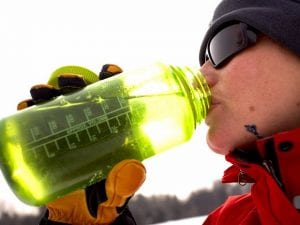It seems like only yesterday that we were discussing how best to keep active during the hot weather which we were lucky enough to enjoy this year – but it’s already time to turn our attention to the time of year that we see more injuries associated with physical activity than any other, winter!
Why exercise in winter is important
It’s (hopefully) common knowledge that exercise is good for you all year round – studies show that even a small amount of exercise can have a positive and cumulative effect on overall health, but it’s also the case that if you stop exercising entirely some of these benefits begin to decline. Despite this, numerous studies continue to show that many of us reduce or abandon our exercise plans over the winter months.[1] Greater access to indoor gym facilities provide a way to counter this, but the gym isn’t for everyone – and despite the trend, there’s no need to abandon your outdoor activities as he temperatures fall.
Winter exercise – the benefits!
While we might not often consider them there are actually some tangible advantages to getting outside and active during the colder months. While these points won’t be everyone’s cup of tea, it’s worth keeping in mind that:
- There’s no heat and humidity to deal with. For many of us, exercising during the summer heat is made unpleasant by humid conditions – winter mornings, by contrast, can be much more comfortable!
- There’s less risk of overheating. If you enjoy the kind of exercise which lasts for a longer period of time, perhaps jogging or even hiking, simply being outside in a cooler environment lowers your risk of overheating.
- You may be able to work out longer in cold weather since you can stay cooler for longer – which means you can burn even more calories.
- It’s a good way to get (some) sunlight. The UK is dark this time of year – there’s no getting away from that, but a morning or evening jog or walk might give you the best possible chance of soaking up any sunlight which is around. Not only can light improve many people’s moods, but it also helps you get some vitamin D.
- Exercise boosts your immunity during cold and flu season. Just a few minutes a day can help prevent simple bacterial and viral infections, according to the Centers for Disease Control and Prevention.
Winter exercise – the risks
Like anything, there are pros and cons here – the major issue in winter is a greater risk of trips or falls, and a greater chance of becoming too cold.
One of the best ways to avoid trips and falls is to ensure that your body is working correctly – even if nothing “hurts” it’s this time of year that small issues with your posture or gait can creep up on you can cause a slip or fall. If you haven’t already, pop in for a chiropractic check-up and ensure that you’re up to date with your adjustments. Taking small steps to help keep your body in balance will allow it to do what it naturally wants to – stay upright! If you are suffering from any aches or pains, now may be the time to be a little more risk-averse – see your chiropractor before you go back out to exercise. Finally, plan where you will be exercising carefully, and keep in mind that the most obvious path or area may not be the best for winter conditions. Runners, for example, may actually be safer running or grass verges or public footpaths as temperatures drop – doing so will allow you to avoid ice which tends to form on hard surfaces like pavement.
Cold temperatures and the risk of becoming too cold needs a bit more planning to deal with. Strong winds and damp conditions (like rain and snow) steal your body heat, and when combined, the wind chill effect makes you feel even colder. For example, on a 30-degree day with 30-mile an hour wind, you’ll feel like it’s about 15 degrees. If you get wet (from rain, snow or perspiration) that effect is only magnified. Now imagine it’s a 5-degree day with a 40 mile an hour wind!
The solution to this problem is to wrap up warm, using layers to allow you to adjust your temperature as you become hotter or cooler during your exercise session. Resist your instinct to start layering with cotton – once cotton becomes wet with sweat or snow, the moisture is trapped and will actually make you feel colder (and heavier). For your first layer, you want something that pulls moisture away from your skin, like the moisture-wicking fabrics used in high-performance sportswear. Next, add a layer of fleece; finally, top with a thin waterproof layer.
If you’re planning a multi-phase exercise session (for example, a workout at the gym followed by a jog home) be sure to take additional, dry, clothes and try to start each segment of your plan dry.
Hypothermia – know the signs
If you follow the above steps, you’ll be able to mitigate the risks of cold and falls to a large extent, but you should always be mindful of the risk of hypothermia. Hypothermia means the body temperature has fallen below 35 degrees Celsius or about 95 degrees Fahrenheit. It occurs when your body can’t produce enough energy to keep the internal body temperature warm enough. If caught early, Hypothermia can be easily managed by warming yourself up promptly – however, if allowed to become serious, it can prove fatal.
Symptoms can include:
- lack of coordination
- mental confusion
- slowed reactions
- slurred speech
- cold feet and hands
- shivering
- sleepiness
The critical thing to remember when it comes to hypothermia is that your risk becomes greater the lower body fat you have – this means that people who are generally fit, regular exercisers actually need to be more vigilant.
[1] For example, Catherine B. Chan and Daniel A. Ryan Assessing the Effects of Weather Conditions on Physical Activity Participation Using Objective Measures Int J Environ Res Public Health. 2009 Oct; 6(10): 2639–2654.
Maciej S. Buchowski et al. Seasonal Changes in Amount and Patterns of Physical Activity in Women J Phys Act Health. J Phys Act Health. 2009 Mar; 6(2): 252–261.

